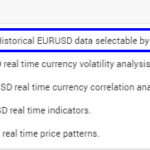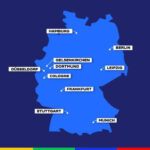Sweden, a Scandinavian gem known for its stunning landscapes and innovative culture, often sparks a common question among travelers: Does Sweden Use The Euro? Despite being a member of the European Union, Sweden has notably decided to keep its own currency. This comprehensive guide will delve into the specifics of Sweden’s currency, payment systems, and what you need to know to manage your finances smoothly during your visit.
Understanding Sweden’s Currency: The Swedish Krona
The official currency of Sweden is the Swedish krona (SEK), often abbreviated as kr. The word “krona” translates to “crown” in English, a name with historical roots. Sweden has maintained the krona since 1873, and it remains a symbol of the nation’s economic independence. The currency is issued by the Riksbank, Sweden’s central bank, which is one of the world’s oldest central banks.
Swedish banknotes come in denominations of 20, 50, 100, 200, 500, and 1,000 kronor, each featuring prominent Swedish figures and landmarks. Coins are available in 1, 2, 5, and 10 kronor denominations. These coins and banknotes are legal tender throughout Sweden. For a detailed look at the current designs, you can refer to the Riksbank’s official website on valid banknotes and valid coins.
Why Not the Euro? Sweden’s Stance on Euro Adoption
Sweden joined the European Union in 1995 but notably opted out of adopting the euro. In a referendum held in 2003, Swedish voters rejected euro adoption, reflecting a desire to maintain economic control and sovereignty. Several factors contributed to this decision, including concerns about the potential impact on Sweden’s economy and social welfare system. Public opinion in Sweden has consistently shown resistance to replacing the krona with the euro.
Economically, Sweden has performed well outside the Eurozone, maintaining a stable economy and its own monetary policy tailored to its specific needs. This economic success has further solidified the country’s commitment to retaining the Swedish krona.
Cashless is King: Navigating Payments in Sweden
Sweden is at the forefront of the global shift towards a cashless society. Cash transactions are becoming increasingly rare, and many businesses actively prefer or exclusively accept card or mobile payments. From bustling city shops to rural cafes, you’ll find that card payments are the norm.
Major international credit and debit cards like Visa and Mastercard are widely accepted across Sweden. American Express may have slightly less acceptance, particularly in smaller establishments, so it’s wise to carry a backup card. Ensure your card is equipped with a chip and PIN, as magnetic stripe cards are not commonly supported.
Can You Use Euros or Other Foreign Currencies in Sweden?
While Sweden is geographically close to Eurozone countries and part of the EU, the euro is not widely accepted as direct payment. In most cases, businesses will expect you to pay in Swedish kronor. While some tourist-centric places like hotels or larger souvenir shops might accept euros, they are not obligated to, and the exchange rate offered is unlikely to be favorable. It is always best to rely on Swedish kronor for transactions.
If you arrive in Sweden with euros or other foreign currencies, you’ll need to exchange them for Swedish kronor. Currency exchange services are available at airports, train stations, and in major cities. Reputable exchange offices include Forex, Tavex, Change Group and Ria. It’s advisable to compare exchange rates online before committing to a transaction to ensure you get the best possible deal.
ATMs and Cash Availability in Sweden
Despite the prevalence of cashless payments, ATMs, known locally as “Bankomat” or “Uttagsautomat,” are readily accessible, especially in urban areas and towns. These ATMs dispense Swedish kronor, and you can typically withdraw cash using international debit and credit cards. Be mindful that your bank may levy fees for international ATM withdrawals, so check your bank’s terms and conditions beforehand.
Carrying a small amount of cash can still be useful for minor expenses or in the rare instance where card payments are not possible. However, for the vast majority of your transactions in Sweden, cards and mobile payments will suffice.
Mobile Payment Solutions: Swish and Alternatives for Tourists
Swish is Sweden’s popular mobile payment app, enabling instant money transfers between users’ bank accounts. However, Swish is linked to Swedish bank accounts and personal identification numbers, making it unavailable for most tourists.
For visitors, relying on contactless card payments and mobile payment options like Apple Pay or Google Pay (where accepted) is the most practical approach. These methods are widely supported and offer convenient ways to pay throughout Sweden.
Currency Regulations: Bringing Money In and Out of Sweden
There are no restrictions on the amount of Swedish or foreign currency you can bring into or out of Sweden. However, if you are traveling into or out of the European Union (EU) and carrying €10,000 or more in cash (or its equivalent in other currencies), you are legally obligated to declare this amount to customs authorities.
In Sweden, declarations are made to Swedish Customs (Tullverket). You can make this declaration online in advance or use a specific form upon arrival. This regulation is in place to combat money laundering and other financial crimes.
Dealing with Outdated Swedish Currency
Sweden has updated its banknotes and coins in recent years. Older versions of the 20, 50, and 1,000-kronor banknotes are no longer valid, and most older coins became invalid in 2017. If you happen to find yourself with outdated Swedish currency, Riksbanken offers a redemption service for invalid banknotes. However, this service involves a fee of 200 SEK per application, making it less practical for small amounts. It’s best to ensure you are using current, valid currency during your travels.
Conclusion: Embrace the Krona and Cashless Convenience
In conclusion, while Sweden is part of the European Union, it proudly retains its own currency, the Swedish krona. For visitors, understanding Sweden’s preference for cashless payments and the dominance of card transactions is crucial. While euros aren’t widely accepted, ATMs are readily available for withdrawing kronor if needed, and card payments are convenient and widely used. By preparing for a largely cashless experience and understanding the nuances of Swedish currency, you’ll be well-equipped to enjoy a seamless and financially smooth journey through Sweden.


